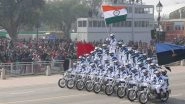Hong Kong, Aug 20 (ANI): China has the ability, through conventional missiles contained within the arsenal of the People's Liberation Army Rocket Force (PLARF), to decimate US military installations around Asia in places like Guam, Japan, Singapore and South Korea. Of course, retaking Taiwan - either forcibly or otherwise - remains the core strategic imperative for China, but the PLA also seeks to deter any American military involvement in such a process.Published just this month by the United States Study Centre at the University of Sydney, a 102-page report entitled "Averting Crisis: American Strategy, Military Spending and Collective Defence in the Indo-Pacific" warned that China's "massive investment in conventionally armed ballistic and cruise missiles is the centrepiece of China's 'counter intervention' efforts."It said, "Over the past 15 years, the PLA has systematically increased, upgraded and extended the range of its inventory of missiles and launchers in what the US government has called 'the most active and diverse ballistic missile development program in the world'."Such is the extent of this missile build-up that the USA may now have to choose whether to enter a conflict that is "enormously costly and dangerous". Alternatively, it could decide to sit on the sidelines and offer up a fait accompli victory to Beijing. The report assessed: "Because America's interests in the security of its allies are 'fundamentally secondary' to its own survival, and arguably less tangible than the core interests Beijing has at stake in many of these flashpoints, Washington may ultimately wager that intervention is not worth the candle."The Pentagon estimates that the PLARF currently fields up to 1,500 short-range ballistic missiles (SRBM), 450 medium-range ballistic missiles (MRBM) and 160 intermediate-range ballistic missiles (IRBM). In addition, it has hundreds of long-range ground-launched cruise missiles.DF-11, DF-15 and DF-16 SRBMs have sufficient range to cover all of the Taiwanese and South Korean territories. Furthermore, from mobile truck launchers stationed on the Chinese mainland, the DF-21 MRBM family can reach all of Japan except it's far north, and more than half the Philippines. One special family member is the DF-21D anti-ship ballistic missile dubbed the "carrier killer".Meanwhile, the DF-26 IRBM can carry either conventional or nuclear warheads. Dubbed the "Guam killer", it puts this strategically important American redoubt in the Western Pacific within comfortable reach, as well as all of Southeast Asia. This is relevant because the US Navy has a logistics base in Singapore, for instance.In other words, the PLARF can threaten every single American base in Asia and in the Western Pacific with these aforementioned conventional missiles, without having to resort to intercontinental ballistic missiles.The United States Study Centre document warned, "This growing arsenal of accurate long-range missiles poses a major threat to almost all American, allied and partner bases, airstrips, ports and military installations in the Western Pacific. As these facilities could be rendered useless by precision strikes in the opening hours of a conflict, the PLA missile threat challenges America's ability to freely operate its forces from forwarding locations throughout the region."Furthermore, Chinese missiles combined with such assets as submarines, advanced aircraft, surveillance assets and surface-to-air missiles "put US and allied expeditionary forces at risk, preventing them from operating effectively at sea or in the air within combat range of Chinese targets".Such a dire warning could hardly be more strident.In fact, when China's regional advantage in ballistic missiles is considered carefully, it is easily comprehended why the USA withdrew from the Intermediate-Range Nuclear Forces Treaty (INF), a key bilateral 1987 agreement between Washington and Moscow that banned the development and deployment of land-based missiles with ranges between 500km and 5,500km, on 2 August 2019.Admiral Harry Harris, former head of the US military's Indo-Pacific Command and now the US ambassador to South Korea, previously testified that the PLARF has "the largest and most diverse missile force in the world, with an inventory of more than 2,000 ballistic and cruise missiles".Signalling the apparent inequality, Harris claimed that 95 per cent of these missiles would violate INF Treaty regulations if China had been a signatory.Adam Ni, a China researcher at Macquarie University in Sydney, explained the reason for Washington's INF pullout. "The US withdrew because of Russian violations. In addition, the US wants to counter China's growing military power in Asia by developing and possibly deploying these missiles to Asia." Indeed, last year Ni told ANI that "Russia is a sideshow" and that the "real action" is against China.Ni elaborated, "China is not a signatory to the INF, and over the last two decades it has developed the world's most sophisticated land-based missile force. The majority of its missiles would have been banned if China had signed on. China aims these missiles at Taiwan and uses them to deter US from regional intervention."Ni pointed out, "China's anti-access/area-denial (A2/AD) strategy is made more effective for the lack of equivalent US missile forces to hold Chinese targets at risk...The key implication for China...is that its A2/AD strategy would be less effective and that its military power projection would be constrained within the disadvantageous confines of the First Island Chain."Ni added, "Despite the Trump White House's fondness for unilateralism, it doesn't want to be unilaterally contained. The US wants to shift that relative balance of military forces in its favour to give it an upper hand vis-a-vis China, and this is part of that effort."Interestingly, just a day after the INF withdrawal occurred, US Defense Secretary Mark Esper confirmed the Pentagon would deploy ground-based intermediate-range conventional missiles to Asia "sooner rather than later". However, allies such as Australia were swift to reject any notion of US missiles being based on their territories.Unsurprisingly, the US withdrawal drew an angry response from the Chinese Ministry of Foreign Affairs via Fu Cong, its director-general of the Department of Arms Control and Disarmament, on 6 August. He expressed China's 'deep regret' over the American decision.He firstly lamented that "the US withdrawal will inevitably have a direct negative impact on global strategic stability, on peace and security in Europe and Asia-Pacific region, as well as the international arms control regime".Secondly, he admitted China is "very much concerned about the announced plans by the US to develop and test land-based intermediate-range missiles". He warned that China "will not stand idly by, and will be forced to take countermeasures if the US deploys intermediate-range ground-based missiles in this part of the world". Without defining these "countermeasures", he warned Asian countries not to countenance such deployments on their soil.Ni echoed this thought. "Beijing will take countermeasures if the US deploys new missiles to Asia. For example, it will put pressure on US allies to not host these missiles. We saw that in 2016 - 2017 when China boycotted South Korean goods as a response to US deployment of the THAAD anti-missile system."Thirdly, Fu declared Beijing "has no interest in participating in the so-called trilateral nuclear arms reduction negotiations with the US and Russia. China pursues a peaceful foreign policy and defensive defence policy. And China sticks to the policy of no first use of nuclear weapons. And over the decades, China has exercised maximum restraint in the development of its nuclear capabilities."Fu denied Chinese hypocrisy, even though it possesses a huge arsenal of ballistic missiles in range classes that Russia and the USA voluntarily chose to relinquish. He said one major difference was that the USA wanted to base its missiles on foreign soil, whereas China only does so on home territory. "So in our case, our missile capabilities are for defensive purposes only, while for the US, because of the forward deployment, these missiles are offensive in nature..."He said if the US deployed such missiles on China's periphery, his country would have the same kind of fear that Americans experienced during the 1962 Cuban Missile Crisis. However, Fu conveniently ignored the fact that China is using its own missile force to hold countries like Taiwan to ransom.Returning to the recently published "Averting Crisis" report, it acknowledged, "The Indo-Pacific presents unique geographical challenges for America." Because of the large distances from the continental USA, challenges include infrastructure, logistics, sealift and networking capacities that are necessary for warfighting and conventional deterrence.Regarded the USA's forward-basing posture, the document stated: "This model of operations is not possible in the Indo- Pacific today as China has exposed the vulnerability of forward concentrated basing. According to some analyses, coordinated attacks by PLA ballistic and cruise missiles on American airbases could destroy 'up to 70 per cent' of their aircraft in the opening stages of a conflict. Others have described the damage to runways, maintenance facilities and associated infrastructure that would prevent their use for over a week in certain combat conditions."As airbases close to potential areas of conflict, such as the Taiwan Strait, have come under threat, mastering the vast distances of the Pacific Ocean has become a greater factor in America's ability to efficiently project military power. Only two airbases - both on Okinawa in the Ryukyu Islands archipelago - are located within the 1,000km unrefuelled range of US tactical fighters from the Taiwan Strait."One example of American inadequacies is the provision of protected shelters for military aircraft. "According to a 2014 estimate, the US military had only 207 hardened aircraft shelters across four bases in the Western Pacific, with most located in South Korea - an increase of just 2.5 per cent over the previous 12 years. The air force has 15 hardened shelters at Kadena Air Force Base on Okinawa; all other bases are either unhardened or shared with allies and partners that may not allow access to their facilities during a US-China conflict. If a major conflict broke out today, the air force could operate up to 190 aircraft from Kadena, the vast majority of which would be 'parked in the open'."The report compared this with the situation in China where, between 2000 and 2012, the PLA grew its hardened aircraft shelters from 92 to 312 across 39 air bases within 800km of Taipei. Those figures represent an increase of nearly 240 per cent.The USA is clearly feeling the pressure, and it believes that nullifying the INF will help to restore balance in its strategic competition with China in the Asia-Pacific region.Already, in the USA's FY2020 defence budget request, three new ground-launched missile systems were mentioned. One is a ground-launched ballistic missile, another is a mobile cruise missile likely based on the existing Tomahawk, and the third is a mobile, land-based medium-range cruise missile. Additionally, the US Army purchased two Iron Dome missile defence systems from Israel in early 2019 for testing and evaluation. What does this new missile race in Asia portend? Ni certainly foresees heightened tensions. "The demise of the INF foreshadows a more dangerous world with more weapons and less trust. If the Cold War taught us anything, it is that humanity had danced on the precipice of Armageddon. What we are seeing today is lessons ignored or forgotten, and the foreshadowing of tragedy." (ANI)
(The above story is verified and authored by ANI staff, ANI is South Asia's leading multimedia news agency with over 100 bureaus in India, South Asia and across the globe. ANI brings the latest news on Politics and Current Affairs in India & around the World, Sports, Health, Fitness, Entertainment, & News. The views appearing in the above post do not reflect the opinions of LatestLY)













 Quickly
Quickly


